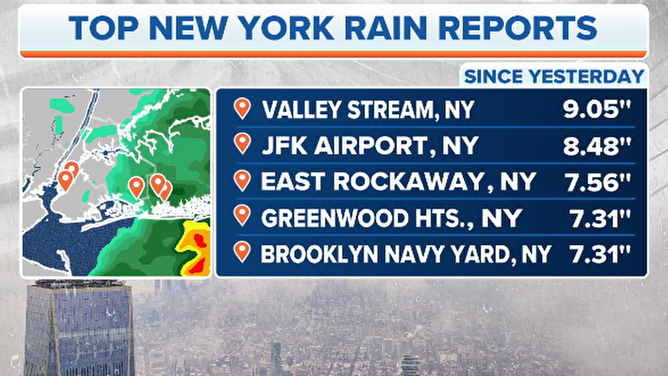Sea lion briefly escapes from Central Park zoo’s pool during severe flooding
Weather observation sites reported rainfall totals of around 5-10 inches around Central Park and JFK Airport.
Sea lion briefly escapes from zoo's pool during flooding
New York’s Wildlife Conservation Society said a female seal lion briefly left her pool’s enclosure at the Central Park Zoo on Friday.
NEW YORK – A sea lion at New York City’s Central Park Zoo temporarily escaped a pool enclosure Friday as the region recorded one of its rainiest days on record and experienced significant flooding.
New York’s Wildlife Conservation Society said the female sea lion was able to swim out of her pool due to the afternoon flooding.
"Zoo staff monitored the sea lion as she explored the area before returning to the familiar surroundings of the pool and the company of the other two sea lions. The water levels have receded, and the animals are contained in their exhibit. No staff or visitors were in danger, and the sea lion remained inside the zoo, never breaching the zoo’s secondary perimeter," the Wildlife Conservation Society said in a statement.
Zoos in the Tri-state area were closed due to the severe weather threat, so visitors weren’t at risk during the event, and the mammal made it back to her pool safely.
PARTS OF NEW YORK SEE WETTEST DAY ON RECORD AS LIFE-THREATENING FLOODING SUBMERGES SUBWAYS, STREETS
Central Park reported between 5-6" of rainfall on Friday, making it the area’s seventh-wettest day on record.
Nearby John F. Kennedy International Airport reported nearly 8.5" during the 24-hour period, making it that site’s rainiest day on record.
Despite the deluge, the zoo did not report any other issues at its facility, and staff devoted their efforts to ensuring the animals weathered the storm.

New York top rainfall amounts
SEE IT: RELENTLESS RAIN IN NEW YORK CITY POURS INTO SUBWAYS, APARTMENTS
The New York Police Department was aware of the event and said all animals were accounted.
As the main corridor of rain pushed off to the east and impacted communities on Long Island and Connecticut, flooding in the boroughs of New York City subsided.
The region’s zoos are expected to reopen as early as Saturday as the weather system that dropped the torrential rainfall heads eastward into the Atlantic.
